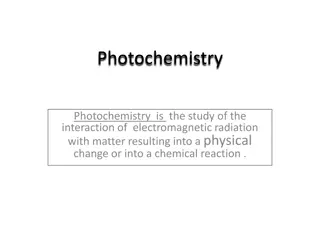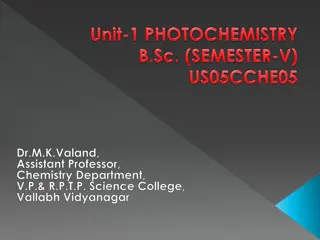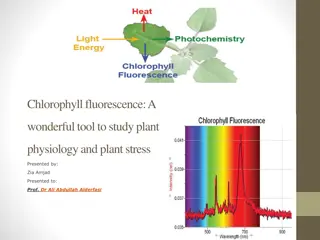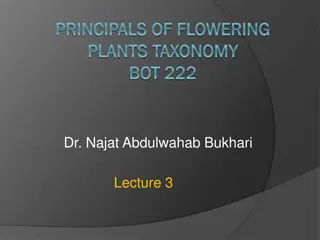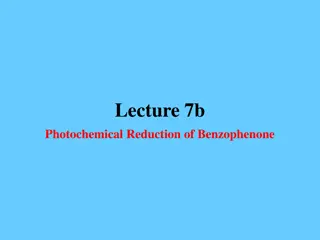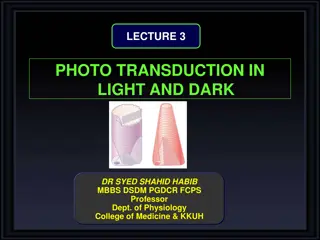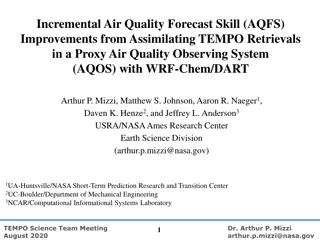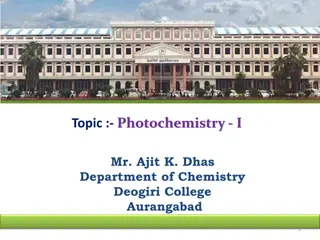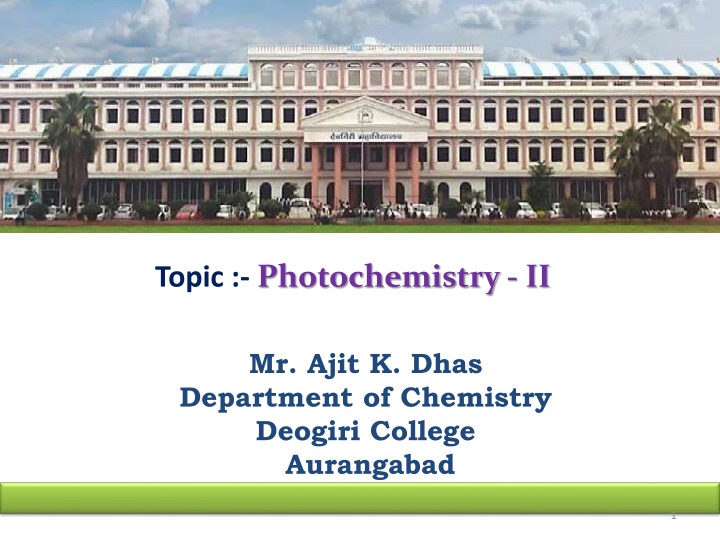
Photochemistry Processes: Fluorescence vs Phosphorescence
Explore the fascinating world of photochemistry with a focus on fluorescence and phosphorescence processes. Learn about the differences between them, their applications, and key concepts such as Jablonski diagram, quantum yield, and more. Discover the intriguing behavior of molecules in excited states and their subsequent energy decay processes, making this an essential read for chemistry enthusiasts.
Download Presentation

Please find below an Image/Link to download the presentation.
The content on the website is provided AS IS for your information and personal use only. It may not be sold, licensed, or shared on other websites without obtaining consent from the author. If you encounter any issues during the download, it is possible that the publisher has removed the file from their server.
You are allowed to download the files provided on this website for personal or commercial use, subject to the condition that they are used lawfully. All files are the property of their respective owners.
The content on the website is provided AS IS for your information and personal use only. It may not be sold, licensed, or shared on other websites without obtaining consent from the author.
E N D
Presentation Transcript
Topic :- Photochemistry - II Mr. Ajit K. Dhas Department of Chemistry Deogiri College Aurangabad 1
B. Sc. III (V Semester) Photochemistry - II
Content Jablonski diagram Quantum yield Chemiluminescence Bioluminescence
Jablonski Diagram 1 0 - 1 1 S e c. S u I . C . S 2 1 0 - 0 8 S e c. S 1 I . S . C . 1 0 - 0 3 -- 1 S e c. T 1 R . D . l i g h t l i g h t R . D . F P 1 0- 0 9 -- 1 0- 0 6 S e c. 1 0- 0 5 -- 1 0 - 0 3 S e c. S 0 F= Fluorescence P= Phosphorescence ISC= Intersystem crossing IC = Internal conversion RD = Radiationless decay.
When a molecule absorbs a photon of energy, electronic transition occurs (S1 or S2 or Sn). A molecule in S1 state undergo one of the following four energy decay processes to the ground state.
Fluorescence: Emission of a photon due to de excitation from singlet excited state to a singlet ground state is called fluorescence. Fluorescence, decays rapidly after the excitation source is removed. Lifetime of the fluorescence is only 10 5 to 10 8 s E.g. Gemstones
Phosphorescence: Emission of photons due to de excitation from triplet excited state to singlet ground state is called phosphorescence. phosphorescence may continue for some time after removing the excitation source. Lifetime for phosphorescence ranges from 10 4 to 104 s. E.g. Stickers, Toys etc.
Difference between Fluorescence and Phosphorescence Fluorescence Phosphorescence Emission of photons by an excited electron during de excitation from a triplet excited state to a singlet ground state is called phosphorescence. Emission of a photon by an excited electron during de excitation from a singlet excited state to a singlet ground state is called fluorescence. Fluorescence, decays rapidly after the excitation source is removed. phosphorescence may continue for some time after removing the excitation source. Lifetime for phosphorescence is large compare to fluorescence. Lifetime of the fluorescence is very small E.g. Gemstones, jelly fishes etc. E.g. Stickers, Toys, bulbs etc.
Non-radiative processes (Internal conversion, Intersystem crossing) Internal Conversion (IC): During internal conversion spin multiplicities of a state remains same. Intersystem crossing (ISC): The molecule may undergo spin inversion to the triplet state (spin unpaired) by a process a radiation less process.
Quantum Yield/Efficiency To compare the number of quantum of energy absorbed with the number of reacting molecule, a term called quantum efficiency or quantum yield ( )has been introduced. Definition: It is the ratio of number of molecule reacted and number of photon absorbed at same time. Number of molecules reacted in a given time therefore, = ------------------------------------------------------------------- Number of photons absorbed in same time
Quantum Yield/Efficiency If a reaction obeys the Stark-Einstein law, one molecule is decomposed per photon, then the quantum yield = 1. When two or more molecules are decomposed per photon, the quantum yield > 1 and the reaction has a high quantum yield. When the number of molecules decomposed is less than one per photon, the quantum yield < 1 and the reaction has a low quantum yield. If the Stark-Einstein law is strictly followed then the quantum yield ( ) is unity.
Problem: 1 x 10-5 moles of product were formed on absorption of 6.0 x 107 erg at 3600 . 1) Calculate quantum efficiency. Ans.- Number of molecules reacted Quantum efficiency ( ) =------------------------------------------------------ Number of quanta absorbed Number of molecules reacted = 1 x 10-5 x 6.023 x 1023 = 6.023 x 1018 molecule Energy of one quantum= h = hc / = 6.623 x 10-27 x 3 x 1010 / 3600 x 10-8 = 5.0 x 10-12 Total energy absorbed = 6.0 x 107 erg (Given) Total quantum absorbed= 6.0 x 107 erg / 5.0 x 10-12 = 1.2 x 1019 Quantum efficiency ( )= 6.023 x 1018 / 1.2 x 1019 = 0.5 Quantum efficiency ( )= 0.5
Problem: 2) A certain reaction absorbed 3 x 1018 quanta of light per second. On irradiation for 20 minutes 0.003 mole of reactant is found to be reacted. Calculate quantum yield for the reaction. Ans.- Number of molecules reacted Quantum yield ( ) =------------------------------------------------------ Number of quanta absorbed Number of molecules reacted = 0.003 x 6.023 x 1023 = 1.8 x 1021 molecule Number of quanta absorbed= 3 x 1018 x 20 x 60 = 3.6 x 1021 Quantum yield ( )= 1.8 x 1021 / 3.6 x 1021 = 0.5 Quantum yield ( )= 0.5
Problem: 3) When substance was exposed to light 0.0025 mole of it react in 20 minute. Calculate quantum yield if substance absorbed 2 x 1018 photon of light per second in the same time. Ans.- Number of molecules reacted Quantum yield ( ) =------------------------------------------------------ Number of quanta absorbed Number of molecules reacted = 0.0025 x 6.023 x 1023 = 1.5 x 1021 molecule Number of quanta absorbed= 2 x 1018 x 20 x 60 = 2.4 x 1021 Quantum yield ( )= 1.5 x 1021 / 2.4 x 1021 = 0.625 Quantum yield ( )= 0.625
Problem: 4) A certain reaction absorbed 3 x 1016 quanta of light per second. On irradiation for 20 minutes 0.002 mole of reactant is found to be reacted. Calculate quantum yield for the reaction. (Ans.- 0.669)
Chemiluminescence Luminescence is spontaneous emission of light by a substance not resulting from heat; it is thus a form of cold body radiation. It can be caused by chemical reactions, electrical energy, subatomic motions or stress on a crystal. It is the reverse of a photochemical reaction. Photo chemical reaction results from the absorption of light while chemiluminescence results due to emission of light from a chemical reaction. A B* B + hv Examples: White phosphorus glows in air with faint greenish colour due to its oxidation. Phosphorus oxidizes to phosphorus trioxide (P2O3 exists as dimerP4O6) oxidises to phosphorus pentoxide (P2O5 exists as dimer P4O10) 4P + 3O2 P4O6* P4O6 + hv P4O6*+2O2 P4O10* P4O10 + hv
Bioluminescence If the luminescence is observed in a biological system, then it is called as bioluminescence e.g. the light emitted by glow-worms, some species of mushroom and fishes shows bioluminescence. e.g. Luciferin(a type of Protein in insect) in the presence of enzyme luciferase and Mg2+ undergo oxidation to Oxyluciferin and CO2 . This Oxyluciferin gives light and shows bioluminescence in fireflies.
Photosensitized reactions Photosensitization is the process of excitation of a molecule by energy transfer from an excited molecule. In this process, a donor molecule (D) absorbs a quantum light and forms an excited molecule (D*). The excited donor molecule then transfers its excitation energy to an acceptor molecule (A)in the ground state in order to excite it. This can be explained using the following reaction sequence: Light absorption: D + hv D* Sensitization: D* + A A* + D The donor molecule is called the sensitizer. The excited acceptor molecule A* could take part either in photochemical reactions or in photo physical processes. Some peroxides are used as a photosensitizer in many photochemical reactions.
Example: A well-known example of photosensitized reaction is photosynthesis. In photosynthesis, Chlorophyll and other plant pigments act as photosensitizer in the synthesis of starch from carbon dioxide and water. A simplified reaction sequence is as follows: Chlorophyll* Chlorophyll + hv 6CO2 + 6H2O + Chlorophyll * C6H12O6 + 6 O2 + Chlorophyll
Phototherapy Phototherapy is treatment with a light. It's sometimes used to treat newborn jaundice by lowering the bilirubin levels in your baby's blood through a process called photo-oxidation. Photo-oxidation adds oxygen to the bilirubin so it dissolves easily in water.
Phototropism Phototropism means the orientation of the growth of a plant towards the direction of light. Plant in a sunlight shows more growth compare to the plant in the shadow. Figure: Image showing phototropism

